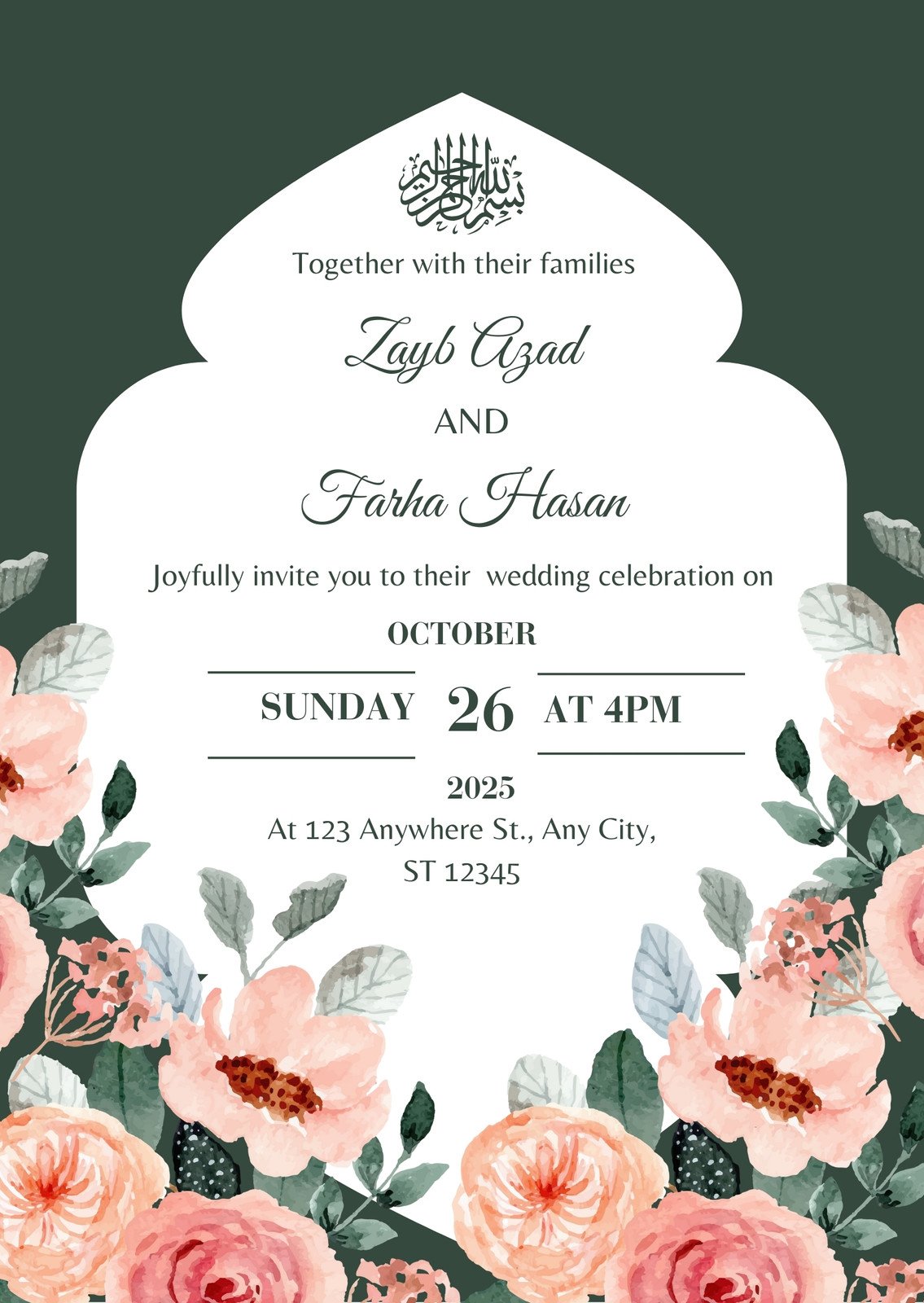Muslim weddings are joyous occasions filled with vibrant colors, rich traditions, and heartfelt celebrations. A key element in setting the stage for these festivities is the wedding invitation. More than just a piece of paper, it’s a reflection of the couple’s personalities and a glimpse into the cultural significance of their union.
Understanding the Importance of Muslim Wedding Invitations
In Islam, marriage is considered a sacred union, symbolizing love, companionship, and the continuation of one’s lineage. The wedding invitation, therefore, serves as a formal announcement of this sacred event, inviting family, friends, and the community to share in the couple’s happiness.
Key Elements of a Muslim Wedding Invitation

While the specific format may vary slightly depending on regional customs and personal preferences, here are some essential elements commonly found in Muslim wedding invitations:
Names of the Bride and Groom
The full names of the bride and groom are prominently displayed, often accompanied by their parents’ names as a mark of respect for family lineage.
Date and Time of the Wedding Ceremony
The exact date and time of the wedding ceremony are clearly stated, ensuring that guests can plan their attendance accordingly.
Location of the Ceremony and Reception
The addresses or venue names of both the ceremony and reception venues are included, along with any necessary directions or maps to help guests navigate easily.
RSVP Information
Clear instructions on how to RSVP are provided, including contact information (phone number, email address) and a deadline for guests to confirm their attendance.
Dress Code (Optional)
While not always explicitly stated, it’s often helpful to include a suggested dress code, especially if the wedding is formal. This helps guests choose appropriate attire for the occasion.
Special Notes (Optional)
This section can include any additional information, such as:
Wedding website: A link to a dedicated wedding website where guests can find further details, view photos, and RSVP online.
Design and Aesthetics
The design and aesthetics of the invitation play a significant role in reflecting the couple’s personalities and the overall tone of the wedding.
Color Schemes
Traditional Colors: Many couples opt for traditional colors like green, gold, and white, which symbolize prosperity, purity, and happiness.
Calligraphy and Typography
Calligraphy is often incorporated into Muslim wedding invitations, adding a touch of elegance and artistry. Arabic calligraphy is particularly significant, as it is used to write verses from the Quran or other religious texts.
Decorative Elements
Floral motifs: Flowers are frequently used as decorative elements, representing beauty, love, and new beginnings.
Cultural Considerations
Muslim wedding invitations often incorporate elements that reflect the couple’s cultural heritage and religious beliefs.
Islamic Verses and Quotes
Verses from the Quran or Hadith, or quotes from Islamic scholars, are often included to bless the couple and invoke divine guidance.
Dua (Supplication)
A short dua (supplication) may be included at the end of the invitation, asking for blessings upon the couple and their future together.
Cultural Symbols
Certain symbols, such as the crescent moon and star, may be incorporated into the design, representing Islamic faith and heritage.
Regional Variations
While the core elements remain consistent, there are regional variations in the style and content of Muslim wedding invitations.
Middle Eastern weddings: Invitations may feature intricate gold foil detailing and Arabic calligraphy.
Modern Trends
In recent years, there has been a growing trend towards more personalized and creative wedding invitations.
Interactive Invitations
Some couples are opting for interactive invitations, such as websites, videos, or social media campaigns, to share their wedding story and connect with guests in a more engaging way.
Eco-friendly Invitations
As environmental consciousness grows, couples are increasingly choosing eco-friendly options, such as recycled paper, digital invitations, and plantable seed paper.
Personalized Touches
Couples are adding personal touches to their invitations, such as hand-lettering, photographs, and unique calligraphy styles, to create one-of-a-kind keepsakes.
Writing the Invitation Text
The wording of the invitation is crucial in conveying the couple’s message and ensuring that all necessary information is communicated clearly.
Formal Language
Traditionally, formal and respectful language is used in Muslim wedding invitations, reflecting the solemnity of the occasion.
Clear and Concise
The invitation should be concise and easy to read, avoiding any ambiguity or confusion.
Proofread Carefully
It’s essential to proofread the invitation carefully for any errors in grammar, spelling, or punctuation.
Sending the Invitations
Once the invitations are designed and printed, they are typically sent out several weeks before the wedding date, allowing guests ample time to RSVP and make arrangements.
Traditional Mailing
Mailing invitations through the postal service is a traditional and widely used method.
Electronic Invitations
Electronic invitations, such as e-cards or online invitations, are becoming increasingly popular, offering convenience and environmental benefits.
Hand-delivered Invitations
In some cultures, it’s customary to hand-deliver invitations to close family and friends as a gesture of respect and personal touch.
Conclusion
Muslim wedding invitations are more than just pieces of paper; they are reflections of the couple’s love, faith, and cultural heritage. By carefully considering the design, wording, and cultural significance of the invitation, couples can create a beautiful and meaningful keepsake that will be cherished by guests for years to come.